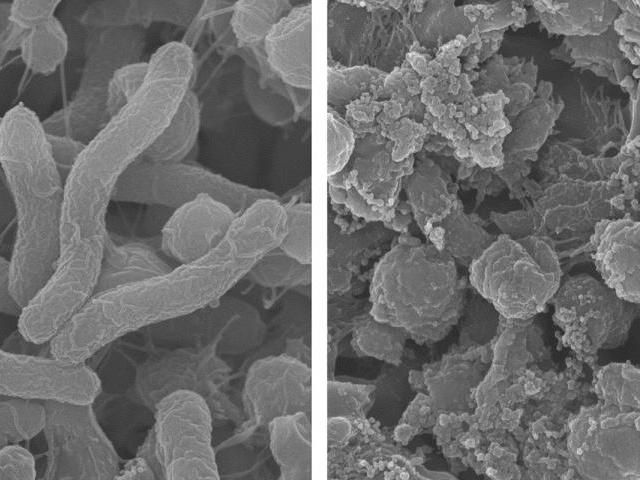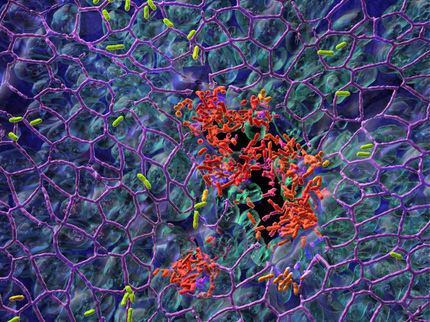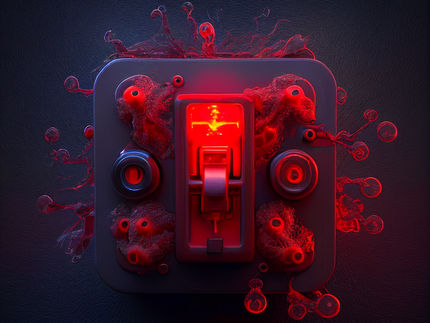Shape-shifting agent targets harmful bacteria in the stomach
Advertisement
A new shape-shifting polymer can target and kill Helicobacter pylori bacteria in the stomach without killing helpful bacteria in the gut. Such a treatment could improve the digestive health of billions of people worldwide who contract H. pylori infections.

At normal tissue pH (left), the polymer is inactive and does not kill bacteria. But in an acidic environment (right), it disrupts bacterial membranes to kill H. pylori in the stomach.
Images courtesy of Jianjun Cheng, University of Illinois
The antimicrobial agent morphs into a bacterial hole-puncher in the stomach's acidic environment and reverts to an amorphous, inactive structure when it reaches the higher pH environment of the small intestine.
The study leaders were Illinois professors Jianjun Cheng, a Hans Thurnauer Professor of Materials Science and Engineering, and Lin-Feng Chen, a professor of biochemistry.
H. pylori infects the lining of the stomach and is a leading cause of stomach ulcers, gastritis and stomach cancer.
"Fifty percent of the world population will have H. pylori infections in their lifetime," Cheng said. "It's a huge market that needs improved solutions, especially in developing countries. Our conformation-switchable polypeptide is the only therapy reported so far that can kill this bacteria at a specific pH range."
The standard treatment for H. pylori infections requires a cocktail of several antibiotics and an agent to reduce acidity in the stomach so that the antibiotics can work. This has the unfortunate side effect of killing off 65 to 80 percent of other bacteria in the digestive tract, Cheng said - bacteria crucial to maintaining digestive health, nutrient absorption and the immune system.
Cheng's group previously developed short protein chains that twist into a helical spiral, giving them a stiff, rodlike structure that can punch holes through bacterial membranes - a method of killing to which bacteria have little ability to develop resistance. With a few simple alterations to the side chains that branch out from the polymer backbone, the researchers were able to create a shape-shifting version of the hole-punching agent.
When in the pH range in most body tissues, the proteins are shapeless and limp, unable to get through cell membranes. But at acidic pH the stomach, they curl up into the spiral rod structures, allowing targeted killing of H. pylori.
"This is a very simple solution to this disease," Cheng said. "These materials become therapeutically effective in the stomach, but once they move to the small intestine - where you have a lot of good bacteria - the pH is neutral or slightly basic and the materials quickly lose their rigid structures. Then they are excreted from the body."
The researchers tested the drug on mice with H. pylori infections from several different cell lines, and found that the drug was effective against the H. pylori while maintaining populations of healthy gut bacteria. Since the mouse stomach has a slightly higher pH than the human stomach, the researchers believe it will be even more effective in the greater acidity of the human stomach, Chen said.
The researchers are performing tests in large animal models as the next step toward human studies. They have obtained a patent and are working toward commercializing the agent as well.
"Traditional treatment involves complicated drug designs and combinations. This drug is very easy to manufacture and scale up. It's just a polymer - a polypeptide chain with amino acid building blocks - and it's biodegradable," Cheng said.
Original publication
Menghua Xiong, Yan Bao, Xin Xu, Hua Wang, Zhiyuan Han, Zhiyu Wang, Yeqing Liu, Songyin Huang, Ziyuan Song, Jinjing Chen, Richard M. Peek Jr., Lichen Yin, Lin-Feng Chen, and Jianjun Cheng; "Selective killing of Helicobacter pylori with pH-responsive helix–coil conformation transitionable antimicrobial polypeptides"; PNAS; 2017
























































